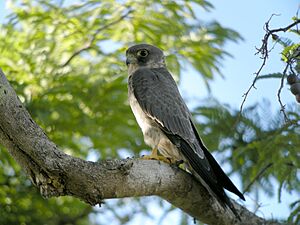Sooty falcon facts for kids
Quick facts for kids Sooty falcon |
|
|---|---|
 |
|
| Allée Des Baobabs near Morondava, Madagascar | |
| Conservation status | |
| Scientific classification | |
| Genus: |
Falco
|
| Species: |
concolor
|
 |
|
| Global range. Orange dots: Breeding colonies Blue: Wintering range |
|
The sooty falcon (Falco concolor) is a cool bird of prey, a type of falcon. It's about the size of a crow. It gets its name "sooty" because its feathers are a dark, smoky gray, like the color of ash or soot. These falcons live and have their babies in places from northeastern Africa all the way to the southern Persian Gulf area.
Contents
Meet the Sooty Falcon: A Bird of Prey
The Sooty Falcon is part of a group of birds called Falconiformes. It belongs to the Falconidae family and the Falco genus. This means it's a true falcon. It's closely related to other falcons known as "hobbies." One of its relatives is Eleonora's falcon.
What Does a Sooty Falcon Look Like?
This elegant bird of prey is about 32–37 centimeters (12-14 inches) long. Its wings can spread out to 78–90 centimeters (30-35 inches). It looks a bit like a large hobby or a smaller Eleonora's falcon. It has long, pointed wings, a long tail, and a slim body.
Adult Sooty Falcons are blue-gray. Unlike the Eleonora's falcon, they don't have black feathers under their wings. Young Sooty Falcons look like bigger versions of young hobbies. You can tell them apart by the dark edges on their wings and tail.
Where Do Sooty Falcons Live?
Sooty Falcons live across Southwest Asia and North Africa. They build their nests and raise their young on islands, coastal areas, or desert cliffs. You can find them from Libya to Pakistan.
These falcons are long-distance travelers. They fly south for the winter to east Africa, Madagascar, and even south-eastern South Africa. In recent years, they've been seen more often in the south, suggesting their winter homes might be getting bigger.
Sooty Falcon Life and Habits
What Do Sooty Falcons Eat?
Sooty Falcons mostly eat other birds, like Sandgrouse. But they also enjoy large insects, such as dragonflies. They catch insects with their feet and then move them to their beak to eat while flying. Sometimes, they even eat lizards and crabs. During the time they are raising their young, they eat only small birds.
How Sooty Falcons Hunt
In winter, these falcons hunt alone or in groups. Sometimes, you can see flocks of up to 15 falcons hunting together. They often sit on trees and catch swarming insects. During the summer, when they are breeding, the male falcons do most of the hunting.
Sooty Falcons use four main ways to catch their food:
- Diving from a perch: They spot prey from a high spot, then dive down fast to catch it.
- Flushing: They fly low over bushes or trees to scare other birds out. Once a bird flies out, they quickly catch it.
- Flying up to come down: If they see a bird flying, they fly higher than it. Then, they dive down to intercept the prey.
- Survey flight: They fly in circles very high up, looking for food. Once they spot something, they fly below it, then turn up into its path to catch it.
Sooty Falcon Reproduction and Nesting
Sooty Falcons lay their eggs in mid-summer. This is unusual for falcons, as most lay eggs earlier. They sometimes nest in groups, which is also rare for falcons. They breed in the hot, dry deserts of Southwest Asia and North Africa during the summer.
They build nests in three types of dry places:
- Small islands in the Red Sea.
- Mountainous deserts.
- Deserts with rocky areas.
They usually nest on a ledge or in rocks, laying up to four eggs. While they prefer high cliffs, they have also been found nesting between rocks or even on the ground. Their nests are often scraped into soft cliffs like limestone or sandstone. They face away from the sun to keep the eggs and chicks cool. Nests also serve as lookout points to protect against predators.
Falcons start showing off and mating in April and May. Eggs are laid by July or August. The eggs hatch after about 27-29 days. The female falcon does most of the sitting on the eggs. The male only takes short turns while the female rests in the sun.
Once the chicks hatch, the male hunts and brings food to the female and the young. During the time the female is sitting on the eggs, the male brings her 3-4 birds every day. Any extra food is hidden on shaded ledges outside the nest. This helps them save food for later and keeps the nest clean from pests. The young falcons stay in the nest for 32-38 days. After that, they stay near the nest for another 2-3 weeks. Their parents still care for them during this time, but then they start to become more independent.
Sooty Falcon Migration
These falcons fly a very long way from their breeding grounds in Southwest Asia and North Africa. They travel to Eastern and South-eastern Africa for the winter. This journey takes about 13 days and covers a distance of 5500 kilometers (about 3400 miles).
The falcons start their migration at night. However, they mostly travel during the day. They make stops along Eastern Africa, usually in places where they can find water.
Protecting the Sooty Falcon
The Sooty Falcon was once thought to be doing well. But recently, scientists found out it's rarer than they thought. Because of this, its status was changed to Vulnerable in 2017. This means it's at risk of becoming endangered.
It's believed that there are only about 2800 to 4000 Sooty Falcons left, and their numbers are going down. Human activity on islands where they breed, especially near beaches, seems to be causing problems. Falcons nesting closer to people have fewer successful nests. So, it's very important to reduce human disturbance and protect their natural homes to help the Sooty Falcon survive.


